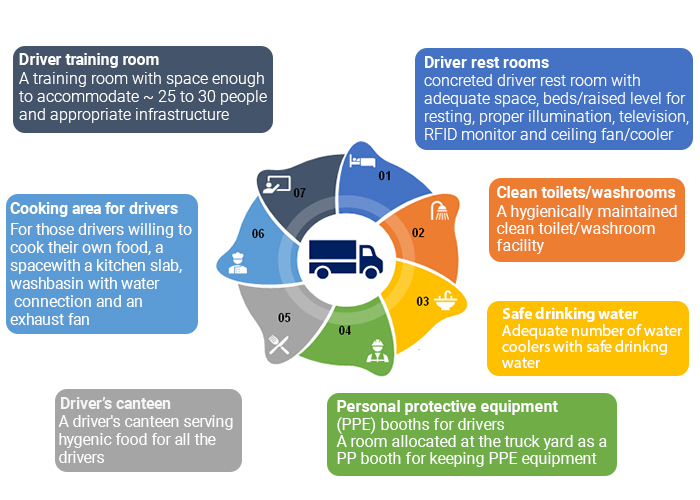The Indian roads network is the second largest network in the world spanning a total distance of over 5.5 million kms, which transports around 58% of the total freight in the Country.1 For the Cement Industry, roads move almost three fourth of the total cement produced in India. Given that the Cement Industry cares about its partners across the value chain and envisions to achieve ‘zero harm’, driver health and safety is a focus area for the Cement Industry.2 Truck drivers are given priority by the Cement Industry through creation of safety and training facilities.
To help improve the health and safety of truck drivers, the Cement Industry has provided them a number of amenities and facilities.
The Cement Industry recognises driver training as one of the critical areas to improve driver safety. A CMA Member Company has ensured that each driver is educated through a Safety Induction Program to enhance operational safety. An animation video on Driver Safety Induction is shown to the drivers. Required infrastructure for driver training such as a Driver Training Room with all required amenities such as desktop, projector, sound system, chairs, etc have been generally developed at the truck parking yards. A CMA Member Company has shared that it is also considering development of a Driver Management Centre at its plants, which will provide defensive driving training, journey risk management and drivers counselling to help make driver training more effective.
Truck drivers spend a certain amount of time loading and unloading material at the cement plant, grinding unit and at the warehouse. Recognising the need to provide decent amenities during wait times, Cement plants provide clean rest rooms, sleeping arrangements, mobile charging points, a sanitisation facility, and a canteen facility with 24X7 food. One of CMA’s Member Companies has implemented Truck Yard Management and Maintenance Guidelines, laying down the following as the minimum basic requirements at their truck yards.


A concreted driver rest room with adequate space, beds/raised level for resting, proper illumination, television, RFID monitor and ceiling fan/cooler.
A hygienically maintained clean toilet/washroom facility.
Adequate number of water coolers with safe drinking water.
A room allocated at the truck yard as a PPE booth for keeping PPE equipment.
A driver’s canteen serving hygenic food for all the drivers.
For those drivers willing to cook their own food, a space with a kitchen slab, washbasin with water connection and an exhaust fan.
A training room with space enough to accommodate ~ 25 to 30 people and appropriate infrastructure.
The Cement Industry regularly engages in sensitising drivers about their health. General health and eye check up camps are organised. Awareness programmes on AIDS and social wellbeing are held. Medical facilities with ambulance for any emergencies are provided inside the cement plant. During Covid-19, a CMA Member Company installed a public address/auto audio system at the plant main gate, invoice yard and parking yard for spreading awareness on Covid-19.
Though a number of initiatives such as introduction of a National Road Safety Policy and creation of Driving Training Centres have been undertaken to improve driver health and safety,3 the driver to truck ratio has been constantly declining. The driver to truck ratio, which was around 900 drivers per 1000 trucks in 2002 has declined to around 600 drivers per 1000 trucks across Industries in India in 2017. This is further expected to decline to 480 drivers per 1000 trucks by 2022.4 This will have serious implications on Indian industry and the Indian economy.
Though a number of measures such as introduction of Goods and Services Tax, which have reduced transit time by 20% and the proposed development of highway village and highway nests on National Highways have been taken, more efforts are required.5 Government thinking is suggestive of prioritising this area. Human resource enhancement and skill development have been chosen as priority areas under the National Logistics Policy. It is vital that a necessary implementation framework be provided to improve driver skill to reduce safety incidents. In addition, infrastructure for truck drivers should also be improved. Road safety signages could be installed on all roads, especially on state highways and hilly terrains. An emergency response mechanism in case of any unforeseen events could be provided across all highways. Parking for vehicles, food court/dhaba, minor repair shops, restrooms and dormitories for drivers could be provided at major cities/junctions across the Country.
As India progresses towards a National Logistics Policy, which will help bring down the logistics cost, it is important that driver health and safety is given due priority to attract the right talent pool. It is, therefore, important that necessary measures are taken at the earliest to drive inclusive growth albeit with safety.
